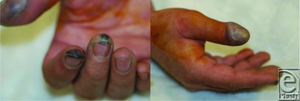We need you! Join our contributor community and become a WikEM editor through our open and transparent promotion process.
Hydrofluoric acid
From WikEM
Contents
Background
- Used in both commercial and home setting
- Rust remover (most common home use)
- Glass etching, chrome and other metal cleaning, petroleum processing
- Oral ingestion has very high mortality rate
- Onset and severity of symptoms correlated with concentration
- Dilute solutions (<20%) may have delayed onset up to 24hr post-exposure
- Moderate solutions (20-50%) develop symptoms within 1-8hr
- Concentrated solutions (>50%) develop symptoms immediately
- These patients are at highest risk for systemic toxicity/death
- Pain immediately (even if wound appears minor) implies severe injury
- Burn itself may appear relatively minor
- Toxicity caused by binding of calcium
Clinical Features
- Skin exposure
- Ophthalmic exposure
- Eye pain
- Erythema
- Ingestion
- Inhalation
- Shortness of breath
- Throat pain/burning
- Signs/symptoms of hypocalcemia and hypomagnesemia
- Can lead to QTc interval prolongation and cardiac arrhythmias, the primary cause of death in HF burns
Differential Diagnosis
Caustic Burns
- Caustic ingestion
- Caustic eye exposure (Caustic keratoconjunctivitis)
- Caustic dermal burn
- Airbag-related burns
- Hydrofluoric acid
- Tar burn
- Cement burn
Evaluation
- Clinical diagnosis
- Trend calcium, magnesium, and potassium levels
- Hydrofluoric acid chelates calcium and poisons the Na+/K+ pump
- Expect hypocalcemia and hyperkalemia
- Monitor EKG for signs of electrolyte abnormality
Management
- Decontamination: remove soiled clothing and irrigate thoroughly.
- Mainstay of treatment is application of calcium to affected area.
Cutaneous Burns
Minor injuries (<50 cm2 from dilute solutions <20%)
- Application of gel paste of Ca gluconate or benzalkonium Cl
- Rub into affected area for 10-15min with pain relief being used as end-point of treatment
- Calcium gel is commercially available (found in industrial first-aid kits)
- Calcium gel can be made:
- Mix calcium gluconate powder 3.5gm with 150mL water-soluble lubricant OR
- Mix 25mL 10% calcium gluconate solution with 75mL water-soluble lubricant
- Benzalkonium Cl is commercially available
- If calcium gluconate is not available calcium chloride can be used
Severe injuries
- Treat with intradermal injections of 5% calcium gluconate
- Prepare by diluting conventional 10% Ca gluconate with sterile NS in 1:1 ratio
- Inject in and around the burned area in amount not to exceed 0.5mL per cm2
Refractory injuries
- Treat with intra-arterial infusion of calcium gluconate
- Deliver via arterial line placed proximal to injury in the same limb
- Infuse 10mL of 10% Ca gluconate dilued in 40mL of NS or D5water over 4 hr
Ocular burns
- Irrigate with saline for at least 5 min
- If persistent pain administer 1% calcium gluconate to eye (dilute 10% calcium gluconate with normal saline)
- Consult ophthalmology due to irritation effect of calcium salts to eye
Ingestion
- If <1hr of ingestion, may consider NG tube for suction and gastric lavage
- Follow lavage by 300mL 10% Ca gluconate down NGT
- Consider intubation for airway protection
Inhalation
- Oxygen via NRB
- Nebulized 2.5% calcium gluconate
Systemic toxicity
- Administer calcium gluconate 100mg IV (10 mL of a 10 percent solution) over 2-3 minutes
- May also need to replete magnesium (4g IV over 20 minutes)
- May see QTc prolongation, cardiac arrhythmia, or obvious systemic illness
- Treat hyperkalemia as needed
Disposition
- Consultation with poison center and burn center transfer per Burn center criteria
- Admission for all patients with arrhythmia on ECG or severe electrolyte disturbance

